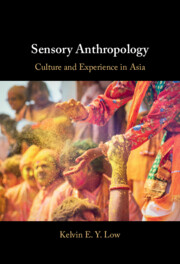Book contents
- Sensory Anthropology
- Sensory Anthropology
- Copyright page
- Dedication
- Contents
- Acknowledgements
- Introduction: How the Senses Are Good to Think With
- Part I Perspectives and Precepts
- Part II Responses and Restitutions
- 3 Sensory Transnationalism and Interfaces
- 4 Gastropolitical Encounters
- 5 Extreme Sensescapes
- Conclusion: Thinking through the Senses
- Notes
- References
- Index
3 - Sensory Transnationalism and Interfaces
from Part II - Responses and Restitutions
Published online by Cambridge University Press: 02 March 2023
- Sensory Anthropology
- Sensory Anthropology
- Copyright page
- Dedication
- Contents
- Acknowledgements
- Introduction: How the Senses Are Good to Think With
- Part I Perspectives and Precepts
- Part II Responses and Restitutions
- 3 Sensory Transnationalism and Interfaces
- 4 Gastropolitical Encounters
- 5 Extreme Sensescapes
- Conclusion: Thinking through the Senses
- Notes
- References
- Index
Summary
In this chapter, I address cross-cultural encounters of two (or more) sets of sensory scripts. These encounters are evident in the wider literature on colonialism, migration and other local–foreign interfaces. In doing so, it serves as an important reminder for one to take heed of multiple axes of sensory similarities and differences, in addition to a merely the East–West core axis of difference. I also turn the lens around by showing how local populations on the reverse, discern colonial or foreign communities through their sensory faculties as a counterpoint. The focus lies in demonstrating how sensory interfaces arising from these processes and movements of people are theorised using the notion of sensory transnationalism. I map this notion onto colonial–local sensory encounters and propose four modes of sensory engagement: reception, rejection, regulation, and reproduction. These modes collectively show how sensory encounters, stemming from contrasting power positions, lend a different understanding of empire and its everyday lived constructions, including how colonial impositions of modernity through sensory regulatory schemes are also met with resistance. Consequently, categories of colonisers and colonised are unsettled instead of being deployed as inherently asymmetrical categories.
Keywords
- Type
- Chapter
- Information
- Sensory AnthropologyCulture and Experience in Asia, pp. 79 - 104Publisher: Cambridge University PressPrint publication year: 2023



